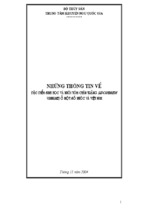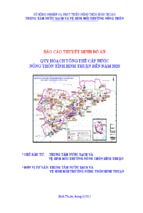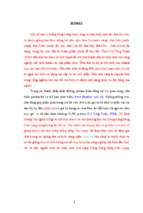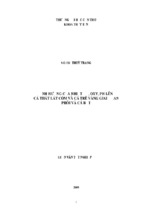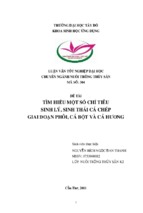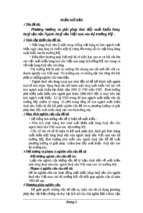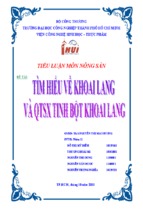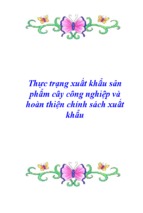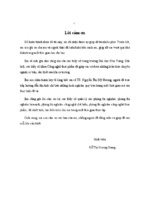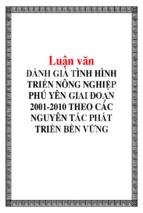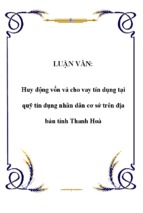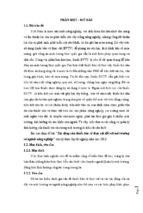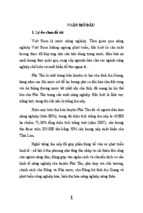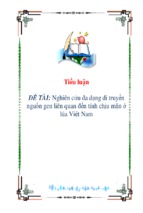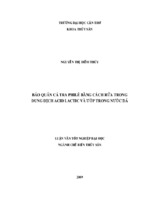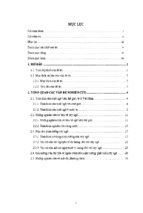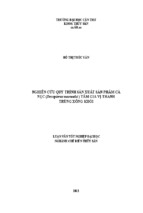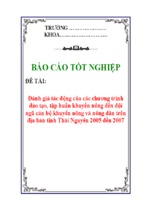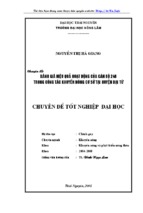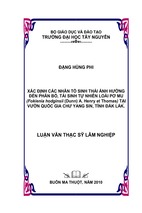THAI NGUYEN UNIVERITY
UNIVERSITY OF AGRICULTURE AND FORESTRY
LE THI THU THAO
ASSESSING THE PERFORMANCE OF WASTEWATER TREATMENT IN
LUYEN THEP FACTORY-THAI NGUYEN IRON AND STEEL JOIN SOCK
CORPORATION
BACHELOR THESIS
Study Mode:
Full-time
Major:
Environmental Science and Management
Faculty:
International Training and Development Center
Batch:
2011-2015
Thai Nguyen September, 2015
Thai Nguyen University of Agriculture and Forestry
Degree Program:
Bachelor of Environmental Science and Management
Student name:
Le Thi Thu Thao
Student ID:
DTN 1153110147
Assessing performance the wastewater treatment in Luyen
Thesis Title:
Thep factory-Thai Nguyen Iron and Steel Join Sock
Corporation
Supervisor:
Assoc. Prof - Dr. Do Thi Lan
Abstract:
The environment is where people live and work. So, the environment has been a
serious problem of society. It is not only a problem of a country but also is a global
problem. It requires that we must take action to protect the environment. One of the
most of the sources of pollution influence on the environment is that waste-water
including domestic waste-water and industrial waste-water.
Currently, the development of science and technology have helped human
achieve the great achievements in the fields of social life. Besides, speed socioeconomic development increasingly more advanced. Industrialized socialization
entails not only economic growth but also the causes of increasing amounts of waste
increase. In addition, the amount of municipal waste, waste from agricultural by
production generated in large quantities when the harvest season. All this trash had the
common characteristic is that it was unclassified.
In Vietnam, every day, big cities and urban areas in the country have over
9100m3 of waste discharged including the amount of municipal waste more than
i
75.4%, the rate of collection is only about 40%-50% and it is pre-treated. The
collection and treatment of solid waste is not thorough causing negative impact on the
environment: stinks, pollution of surface water, underground water, soil pollution,
pathogens and the spread of disease...
Industrial Thai Nguyen Iron and Steel were the main supplier for market about
raw materials in steel industry. Besides, the steelmaking process also releases large
amount of waste causing environmental pollution. So, through the process “Assessing
the performance of waste-water treatment in Luyen Thep factory-Thai Nguyen Iron
and Steel Join Sock Corporation”. From there, we can give some solution appropriate
to deal with minimize the environmental pollution problem in factory.
Key words
Performance treatment, rain-water overflowing, domestic
waste-water, industrial waste-water, processes treatment.
Number of pages
54 pages
Date of submission
30/9/2015
ii
ACKNOWLEDGMENTS
Practice is the participatory process to learn, observe, study and manipulate
application of knowledge learned into practice the work of environmental management
of the factory.
Internship report is an opportunity for students to present on issues of their
interest in the course of practice, as well as an important document to help teachers
examine and evaluate the learning process and results practice of each student.
To complete this internship report during practice at Luyen Thep Luu Xa
factory-Thai Nguyen Iron and Steel Join Sock Corporation. I wish to express my
thanks to:
- Associate Professor - Dr. Do Thi Lan lecturer of Environmental Science - Nong Lam
University direct teacher's guide me in this internship. She instructed during practice
and build reports.
- Ms Nguyen Van Bao - Manager, working at Department of Engineering Technology
and Luyen Thep Luu Xa factory - Thai Nguyen Iron and Steel Join Sock Corporation
and everyone in factory interested, helped and facilitated. They enabling for me
exposed to environmental work of factory during the practice, and helped me in the
process of implementing the report.
I sincerely thank you!!!
Student
Le Thi Thu Thao
iii
TABLE OF CONTENTS
ACKNOWLEDGMENTS ......................................................................................................... iii
TABLE OF CONTENTS .......................................................................................................... iv
LIST OF TABLES ..................................................................................................................... 1
LIST OF FIGURES .................................................................................................................... 2
LIST OF ABBREVIATIONS .................................................................................................... 3
PART I: INTRODUCTION ....................................................................................................... 4
1.1 Research rationable........................................................................................................... 4
1.2. Research’s objectives ...................................................................................................... 5
1.2.1. Request of topic ............................................................................................................ 5
1.3. Research question and hypotheses .................................................................................. 5
1.4. Limitations ....................................................................................................................... 5
1.5. Definitions ....................................................................................................................... 6
PART II: LITERATURE OVERVIEW ................................................................................... 11
2.1. The legal basis .............................................................................................................. 11
2.2. Practical basis ................................................................................................................ 12
2.3. The research situation of water pollution in the world and Vietnam ............................ 13
2.3.1. Research situation of water pollution in the world ..................................................... 13
2.3.2. Research situation of water pollution in Vietnam ...................................................... 15
2.4. Environmental situation of steel production in the world and Vietnam ........................ 18
2.4.1. Environmental situation of steel production in the world .......................................... 18
2.4.2. Environmental situation of steel production in Vietnam ............................................ 19
PART III: METHODS ............................................................................................................. 21
3.1. The research methodology ............................................................................................ 21
3.1.1. Methods of data collection, analysis and synthesis of secondary documents ............ 21
3.1.2. Methods of collecting and processing of data and documents ................................... 21
3.2.3. Methods sampling and analysis .................................................................................. 21
iv
3.4. Monitoring Parameters .................................................................................................. 22
PART IV: RESULTS AND DISCUSSION ............................................................................. 25
4.1. Introduce to Luyen Thep-Luu Xa factory-Thai Nguyen Iron and Steel Join Sock
Corporation ........................................................................................................................... 25
4.1.1. General information.................................................................................................... 25
4.1.2. Summary process and status operations of factory .................................................... 26
4.1.3. The demand of production and activities ................................................................... 27
4.1.4. Production area ........................................................................................................... 28
4.1.5. The apparatus of factory ............................................................................................. 31
4.2. Natural conditions and environment factory ................................................................. 32
4.2.1. Conditions about geography and geology .................................................................. 32
4.2.2. Conditions about meteorology-hydrology .................................................................. 32
4.3. Status of wastewater in factory...................................................................................... 36
4.3. Wastewater treatment technology ................................................................................. 40
4.3.1. For domestic wastewater ............................................................................................ 40
4.3.2. For rain-water overflowing ......................................................................................... 42
4.3.3. For industrial wastewater............................................................................................ 43
4.4. Results of measuring and analyzing of wastewater ....................................................... 45
PART V: DISCUSSION AND CONCLUSION ...................................................................... 50
5.1. Discussion...................................................................................................................... 50
5.2. Conclusion ..................................................................................................................... 50
REFERENCE ........................................................................................................................... 52
APPENDICES .......................................................................................................................... 55
v
LIST OF TABLES
Table 4.1- The average temperature in months of year ............................................................ 33
Table 4.2- Average humidity air in months .............................................................................. 34
Table 4.3- The system of flow on the characteristics of surface .............................................. 37
Table 4.4- Weight and concentration of domestic wastewater ................................................. 39
Table 4.5- Results of measuring and analyzing industrial wastewater..................................... 45
Table 4.6- Results of measuring and analyzing domestic wastewater ..................................... 48
1
LIST OF FIGURES
Figure 4.1- Geographical location of Luyen Thep-Luu Xa factory…………………………. 24
Figure 4.2- Diagram sampling location……………………………………………………... 25
Figure 4.3- The location of diagram contiguous side of Luyen Thep factory………………. 29
Figure 4.4- Diagram of the overall factory premises………………………………………... 30
Figure 4.5- The organization of diagram in factory ……………………………..………….. 31
Figure 4.6- Structure of septic tanks…………………………………………………..…….. 41
Figure 4.7- Diagram treatment systems and electric furnace wastewater ...…………..……. 43
Figure 4.8- Diagram treatment systems and casting machines wastewater…………............. 44
Figure 4. 9- Diagram of cooling water cyclic 2nd……………………………………..…….. 44
Figure 4.10- The indicator of BOD5 ………………………………………........................... 47
Figure 4.11- The indicator of COD......................................................................................... 47
Figure 4.12- The indicator of TSS........................................................................................... 48
2
LIST OF ABBREVIATIONS
MONRE: Ministry of Natural Resources and Environment.
LEP: Law on Environmental Protection
EIA: Environmental Impact Assessment
TVA: Tennessee Valley Authority
SIWI: International Water Institute
FAO: Food and Agriculture Organization
UNICEF: United Nations Educational Scientific and Cultural Organization
BOD: Biochemical Oxygen Demand
COD: Chemical Oxygen Demand
TSS: Total Suspended Solids
3
PART I: INTRODUCTION
1.1 Research rationable
Currently, waste-water treatment is hotly issue and emerge in Vietnam.
According to the forecast of world economic organizations, Vietnam will be one of the
countries had speed of economic rapid development in the world and it is forecast to
be 7% in the next decade. However, the economic growth quickly and strongly will
also create pressure challenge impact to come environment.
After over 30 years of implementing the process of industrialization and
modernization, Vietnam has industrial zones, export processing zones and high-tech
zones in 57/64 provinces, attracting tens of thousands of construction projects plant
with all sorts of career. Besides, producing a large volume of products to serve the
domestic demand and exports, industrial establishments also consumes a huge amount
of natural resources and energy, and emissions into the environment the corresponding
amounts of waste (liquid, gas, solid and sludge). Inside, waste-water is often issue
most concerned because it often has heavy traffic, pollution concentrations highly and
contaminated components difficult to handle.
Iron and Steel Industrial Zone - Thai Nguyen is the important industrial area in
the Northern of province. The waste-water treatment here is an important step, which
affects directly or indirectly the lives of neighboring residential areas, ecosystems and
biodiversity.
The performance evaluation of waste-water treatment at the plant of industrial
Gang Thep - Thai Nguyen helps us have a look overall level of impact on the
environment, propose some management measures, waste-water treatment to be better.
4
Under the guidance directly by Associate Professor - Dr. Do Thi Lan. I studied
the topic "Assessing the performance the wastewater treatment in Luyen ThepLuu Xa factory-Thai Nguyen Iron and Steel Join Sock Corporation ".
1.2. Research’s objectives
-Determining the performance of wastewater treatment at Luyen Thep Luu Xa factory
- Research situation of environment in factory.
- Proposing solutions to increase efficiency of wastewater treatment to achieve
effective highest wastewater treatment.
1.2.1. Request of topic
- Assessing the true state of the processor performance of the wastewater treatment
zones at the plant and the environmental situation of the Luyen Thep factory.
- Propose solutions to increase efficiency of wastewater treatment.
- The results of analysis of environmental quality parameters of water, compared to
TCVN 40: 2013/ MORNE.
1.3. Research question and hypotheses
- What is an overview of Luyen Thep factory?
- What is current research situation of wastewater in factory and Viet Nam?
- What is formula of performance?
- How is performance of the wastewater treatment?
- What are possible management and technology solution to reduce water pollution of
factory?
1.4. Limitations
Thesis was conducted during 4 months from March 2015 to July 2015. Thai
Nguyen Join Sock Corporation has 25 factories. Each factory has many environmental
5
problems such as water, air, soil noise,…and this thesis just assesses problem of water
pollution and water source can be from other places. So, the measuring results may not
be completely accurate.
1.5. Definitions
Environmental concept: In fact, there are many different definitions of the
concept of "environment" According to Vietnamese Dictionary: "The environment is a
combination of factors outside of a certain system. We impact on this system and
identify common trends in the world, the environment of an object, or an event general
external condition affecting objects and events ".
The functions of the environment:
- The environment is the living space for people and animals world.
- The environment is the place to contain the resources necessary for the life and
human production.
- The environment is the place to contain the waste created by humans in the process
of living.
- Functions for storing and providing information to people
- Protecting people and organisms from external impacts.
The concept of water:
- Water is a chemical compound of oxygen and hydrogen. The chemical formula is
H2O. With special physical and chemical properties (eg: bipolar, hydrogen bonding
and abnormalities of specific weight), water is a very important quality in many
branches of science and in the life, 70% of the area of the Earth covered by water, but
only 0.3% of all water on Earth can be exploited for drinking.
6
Fresh water is a renewable resource; however, the supply of fresh and clean water in
the world is gradually reduced. Demand for water has exceeded supply in some parts
of the world, while the world population continues to rise as increasing water demand.
The awareness about the importance of protecting water resources to ecosystem only
been voiced recently. (Loan, 2005)
The concept of water pollution:
Water pollution: is change the worsening of physical - chemistry - biological of
water, with the presence of strange substances in liquid, solid make water become
toxic to humans, organisms and reduce biodiversity in water. In terms of transmission
speed and scale of the impact of water pollution is more worrying problem of land
pollution. Water pollution occurs when surface water flows through domestic waste,
industrial waste water, the pollutants on the ground and infiltration into groundwater.
The phenomenon of water pollution occurs when toxic chemicals, pathogenic bacteria,
viruses, parasites arising from various waste sources such as industrial waste from the
manufacturing plant, the waste of hospital, domestic waste types of human or
chemicals, pesticides, organic fertilizers ... used in agricultural production. They are
pushed out of ponds, lakes, rivers, streams or seep into groundwater without being
processed or too large volume beyond self-regulation and self-cleaning of all kinds of
ponds, lakes, rivers and streams. (Tuan, 2013)
Water pollution has natural origin: by rain, snowmelt, flooding, wind storms
... or so active products of living organisms, including their corpses. Plants and
organisms die which are decomposed into microbial organic matter. A part will seep
into the ground, then deep into the ground water, polluting the air or groundwater flow
mixed in large lines water. Flooding can do loss of clean water, stir the dirt in the
7
sewers, bring many toxics waste from a garbage dump and entrainment of chemicals
had previously been kept. Floodwaters may be contaminated by chemicals used in
agriculture, industry or toxic agents in the waste area. Cleanup workers nearby may be
affected by chemical pollution of water. Water pollution from natural factors
(volcanoes, erosion, storms, floods,..) can be very serious, but not often, and not the
main cause of water quality degradation globally. (JG Arbuckle, MA James, ML
Miller and TFP Sullivan , 1976)
Water pollution has artificial origin: The discharge of toxic substances mainly
in the form of liquid such as domestic wastes, industry, agriculture, and transport to
the water environment.
According to the nature of the polluting factors, it is divided into types of water
pollution: pollution of inorganic, organic, chemical pollution, biological pollution,
contaminated by physical agents.
Pollution source from industrial activities is one of the greatest pollution of
artificial pollution source. The development of many industries brings many dusties
with different caliber globally. It has created a huge volume of liquid and solid, air
wastes flows into the environment makes environmental quality decline. Especially, in
many developing countries and least developed countries, in many cities and industrial
zones of this country untreated or poorly treated directly discharged into the
environment makes the environment serious pollution. (JG Arbuckle, MA James, ML
Miller and TFP Sullivan, 1976)
The concept of wastewater: wastewater which after being used or created in a
technological process and no direct value to that process
What is the wastewater treatment?
8
Wastewater treatment is a combination of process and treatment methods which
make the waste water from the company, the factory ... becoming cleaner, thereby
reducing water pollution around.
- The concept of value-water quality: According to Escao (1994), water quality is
assessed by parameters, the criteria are:
+ The physical parameters such as:
- Temperature: Temperature affects the biochemical processes taking place in natural
water sources. The change in temperature leads to changes about water quality, speed,
shape decomposition of organic matter, dissolved oxygen concentration.
- pH: The index of acid or base of water is environmental factors affecting to growth
and the limited development of microorganisms in water. In the field of water, pH is a
factor to consider in the process of chemical coagulation, disinfection, water softening,
and corrosion control. In wastewater treatment system by biological processes, the pH
must be controlled in the appropriate range for the microorganism concerned. pH is the
environmental factors affecting growth and limits the growth of microorganisms in the
water.
+ The chemical parameters such as:
- BOD (Biochemical Oxygen Demand): The amount of oxygen necessary which
provide for microorganisms decomposition of organic matter in standard conditions of
temperature and time.
- COD (Chemical Oxygen Demand): The amount of oxygen needed to oxidize
chemicals in water.
- The heavy metal elements: Heavy metals are elements that proportion of them is
equal to or greater than 5 as Arsenic, Cadmium, Fe, Mn ... With small quantities, they
9
need for development and growth of animals and plants. But, the number of
concentration is increased; they become toxic to animals and humans through the food
chain.
The concept of industrial waste water and properties of industrial wastewater:
Industrial wastewater is wastewater generated in industrial production processes.
- For industrial plants have two kinds of waste water: domestic waste water and
production waste water:
+ Domestic wastewater include: domestic wastewater from the preparation and
processing of food in the factory cafeteria, domestic wastewater of worker...
+ Industrial wastewater is kind of wastewater generated in the production process of
the company, enterprise ... depending on materials, manufacturing technologies. Thus,
the pollution levels will be different.
10
PART II: LITERATURE OVERVIEW
2.1. The legal basis
Assess the status environment is performed on the basis of provisions of
following documents:
- LEP 2014 No. 55/2014/ National Assembly 13 passed by the National Assembly of
Vietnam (Socialist Republic of Vietnam) XIII, 7th session, adopted on 06.23.2014.
- Water Resources Law No.17/2012/ National Assembly 13 was passed by the
National Assembly of Vietnam (Socialist Republic of Vietnam) XIII, 3rd Session
adopted on 21.06.2012 and entered into force on 01/01/2013.
- Decree 18/2015/Government decree - about environmental protection planning, EIA,
Environmental Protection Plan.
- Decree No. 19/2015/Government decree - detailing the implementation of some
provisions of environmental protection law.
+ The regulations of Vietnam:
- QCVN 40:2011/MORNE - national technical regulations on industrial wastewater.
- QCVN 50:2013/MORNE - national technical regulations on hazardous threshold for
the sludge from the water treatment process.
- QCVN 52:2011/MORNE - national technical regulations on wastewater
- QCVN 08:2008/MORNE - national technical regulations of quality.
- QCVN 09:2008/MORNE - National technical regulations on groundwater quality.
- QCVN 14:2008/MORNE - national technical regulations on waste water.
+ The standards of Vietnam:
11
- TCVN 6491:1999 ISO VN 6060: 1989 Water quality - Determination of chemical
oxygen demand.
- TCVN 6772:2000 Water qualities - Domestic wastewater pollution limits allowed.
- TCVN 6980:2001 Water qualities - Standard of industrial waste water discharged
into these basins for water supply capacity.
- TCVN 6981:2001 Water qualities - Standard of industrial waste water discharged
into the lake basin capacity for water supply purposes.
2.2. Practical basis
Currently, our country is in the open era of development the industry. Thus, the
industrial zone, the industrial factories were built more to meet the goals of
industrialization and modernization. But coupled with industrial development is
required to preserve environmental protection especially in industrial areas and
factories.
The industrial zones and factories were opened to promote economic
development also caused considerable problems especially environmental issues.
Current situation in the factory environment is showing signs of pollution from waste
sources in the production process. So, we need to have programs for pollution control
in the factory every year to be aware of the environmental status and timely corrective
direction when the phenomenon of pollution. (SN Luoma, PS Rainbow and S Luoma,
2008)
12
2.3. The research situation of water pollution in the world and Vietnam
2.3.1. Research situation of water pollution in the world
In the 60s, water continent pollution and ocean growing at worrying pace.
Progress of water pollution gives an industrial development true progressive. I could
name a few typical examples.
In Charleston on January 9, about 10,000 gallons of a little-known and
unregulated chemical called 4-methylcyclohexane methanol leaked from an
aboveground storage tank into the Elk River. The amount of the chemical
overwhelmed the carbon filtration system in the West Virginia American Water
treatment plant about a mile downstream. Within a week, more than 400 people were
treated at hospitals for rashes, nausea, vomiting, and other symptoms. (Drastic, 2002)
A chemical spill that left 300,000 residents of Charleston, West Virginia, without
tap water last month is raising new concerns about the ability of the United States to
maintain its high quality of drinking water. (Drastic, 2002)
In 2008, the dike at an impoundment in eastern Tennessee failed at the TVA
Kingston Fossil Plant. More than 5.4 million cubic yards of coal ash spilled from the
site and spread across more than 300 acres of land and water. Tests of nearby river
water showed levels of lead and thallium exceeded safety limits for drinking water, but
the TVA said at the time that the toxic metals were filtered out by water treatment
processes. The TVA spent a year and a half cleaning up the sludge. (Dunlap, Riley E.,
and Andrew K. Jorgenson, 2002)
China’s booming economy and massive population are posing some difficult
environmental challenges for a nation of some 1.2 billion people. Water pollution and
waste management are among the most pressing issues. China produces over 3.5
13
million tons of sewage waste per day. To treat just half that amount, they would need
to invest in 10,000 treatment facilities. Some modern wastewater treatment plants and
sanitation systems do exist, but many more are required. Perhaps half of all Chinese a
staggering 600 million people drink water that is contaminated by human or animal
waste. These people are subjected to waterborne disease and a myriad of human health
concerns related to the use of polluted water. China’s major river systems exhibit the
scope of the problem. Perhaps 70 percent of their water is so polluted that it has been
deemed unsafe for human contact. In addition to untreated sewage released into these
waterways, high-growth industries such as textiles, paper manufacturing, chemicals,
and pharmaceuticals account for a large share of this pollution. (Garcia, Serge M., and
Christopher Newton, 1995)
According to the United Nation‘s Food and Agricultural Organization, China
also is the world’s largest consumer of synthetic nitrogen fertilizers. When an
excessive amount of nitrogen and other chemicals used in fertilizers is introduced into
a waterway, an imbalance of organic materials can occur which leads to increased
algae blooms. Increased algae blooms negatively affect the water supply and have
already led to the temporary closure of drinking water plants in some areas of China.
(Qu, Jiuhui, and Maohong Fan, 2011)
Average per day on earth there are about 2 million tonnes of municipal waste
dumped into rivers and seas, 70% of industrial waste without treatment being directly
discharged into water sources in developing countries. These are the statistics of the
SIWI is announced at World Water Week kicks off in Stockholm, the Swedish capital
5/9 days. In fact, water is used in daily life of people with serious pollution. Half of the
patients hospitalized in the developing countries are due to lack of access to adequate
14
- Xem thêm -


